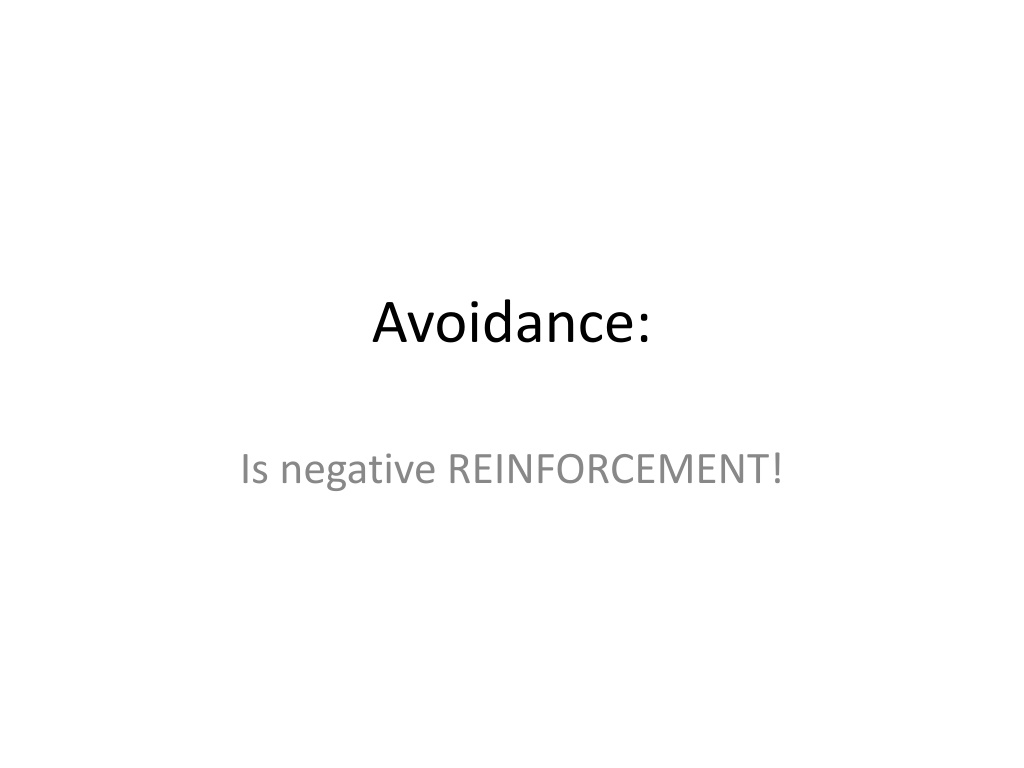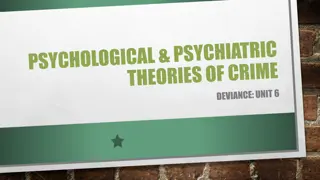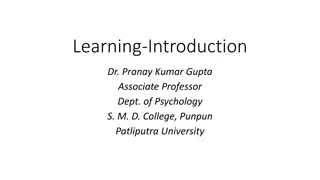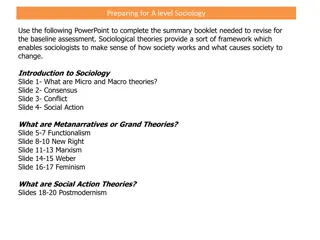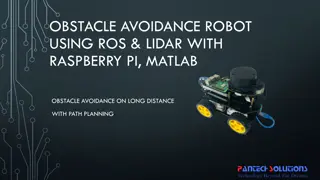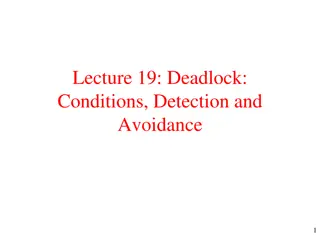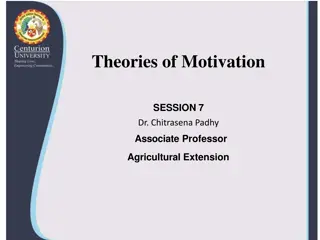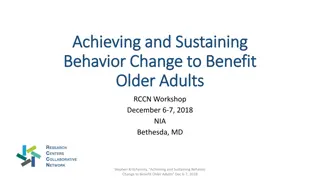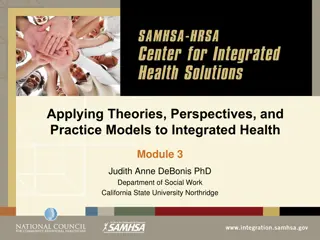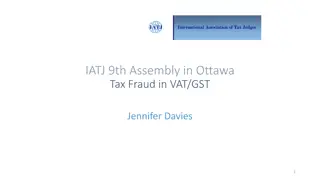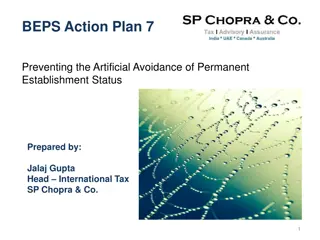Understanding Avoidance Behavior and Its Theories
Avoidance behavior involves negative reinforcement to increase the frequency of operant responses, not punishment. Different types of avoidance tests, such as discriminated avoidance and shuttle avoidance, are used to study negative reinforcement. The Two-Factor Theory of avoidance conditioning explains how animals learn to fear and avoid aversive stimuli. Experimental evidence supports the idea of fear reduction through the escape response in avoidance conditioning.
Download Presentation

Please find below an Image/Link to download the presentation.
The content on the website is provided AS IS for your information and personal use only. It may not be sold, licensed, or shared on other websites without obtaining consent from the author. Download presentation by click this link. If you encounter any issues during the download, it is possible that the publisher has removed the file from their server.
E N D
Presentation Transcript
Avoidance: Is negative REINFORCEMENT!
What is avoidance behavior? Avoidance contingencies INCREASE the rate of an operant response NOT punishment, but actually negative reinforcement Remember, punishment DECREASES the response But with both avoidance and punishment the organism reduces contact with an aversive stimulus! Increasing periods of safety Avoidance procedures = ACTIVE avoidance Punishment procedures = passive avoidance
Avoidance Tests: Discriminated Avoidance Discriminated Avoidance: Procedure for studying negative reinforcement and avoidance A response CANCELS a shock Organism is responding for food reinforcers When light comes on, must press another lever to AVOID the shock IF the response does not occur during the S+ the stimulus is followed by a shock IF the response does occur during the S+, the shock is cancelled thus: signal or sD for shock if this were an escape: response could also occur DURING the shock to shut off shock
Shuttle Avoidance 1-way shuttle avoidance: Animal on one side of a shuttle Cue comes on: Must jump to other (safety) side or receive a shock. Placed back in original side for each trial. 2-way shuttle avoidance Animal on one side of a shuttle Cue comes on: Must jump to other (safety) side or receive a shock. But: previously SAFE side then becomes shock side Animal must jump back into shock side to get away from shock. VERY Difficult for animal to learn.
Theories of Avoidance: Two Factor theory Two things happen during avoidance conditioning: CC and then OC Animal learns to fear S+ via class. conditioning CS (light)---> US (shock): UR (fear) animal learns to fear light via pairing with shock Animal will then learn a response to AVOID shock and thus remove/lessen their fear Thus: not getting shocked reduces fear that was signaled by the CS
Theories of Avoidance: Two Factor theory Experimental evidence: On initial training trials: light/CS produces physiological symptoms of fear Escape response results in decrease in these physiological symptoms On later trials: little or no evidence of physiological fear with CS presentation suggests fear has been reduced/replaced by the escape response In sense: forms a negative feedback loop
Problems with 2-factor theory: Signs of fear dissipate w/time: as animal gets "better" at avoidance response thus: no fear to be avoided The CS is not as important in avoidance learning as 2-factor theory states: Animals can learn to avoid in a discriminated avoidance situation long before there is any sign that they are responding to/detecting the CS
Two Avoidance Procedures: Sidman Avoidance: The response POSTPONES or DELAYS the shock Thus: only temporary solution Must keep responding to keep delaying the shock Results in lots of responding Again: some signal may be used to signal when must respond
Two Avoidance Procedures: Herrnstein and Hineline Procedure: The response reduces the rate of the shock Does NOT delays or cancel, just slows down rate of delivery The response switches the schedule of shock to a lower rate Note: cannot entirely AVOID shock in this procedure: once animal receives shock on lowered schedule, reverts back to original schedule animal must respond again to switch schedule again
Herrnstein and Hineline: Test of 2-factor theory Test of 2 factor theory: Two groups of rats used Group 1: Can turn off light, but still get shock Group 2: Can turn off shock, light still on 2-factor theory would predict that Group 1 should respond more, because this would be cancelling the CS that produces fear Results: group 2 responds much more accurately, faster
Alternative: One-Factor Theory Responses occur whenever they reduce the rate at which aversive events occur When a CS is present: only providing information about the effectiveness of a response Fear may be a by-product of avoidance training, but not crucial to learning/ maintaining an avoidance response
Evidence for One-Factor theory Almost postulating a "cognitive" theory of avoidance: Seligman and Jonston (1973) did postulate cognitive theory: like Rescorla Wagner theory in that deals with predictability Basic premise: Learning occurs only when there is a discrepancy between observation and expectation Subjects' behavior will change in avoidance task whenever there is a discrepancy between expectancy and observation
Evidence for One-Factor theory Two important expectations in avoidance task: Expectation about consequences of a response Expectation about consequences of not responding Data support One-factor theory On trial 1: no expectations On trial 2 (and more): expectation about what will happen no shock will occur if response is made Shock will occur if no response is made Animal prefers no shock to shock- so responds Contingency is what is important in avoidance, fear is by-product!
Safety-Signal Hypothesis In avoidance: Cannot forget that there is positive reinforcement through conditioned inhibition of fear That is, are rewarded for reducing fear through the avoidance response Thus avoidance response is (obviously) reinforced But so are signals that occur with that response Conditioned safety signals! Performance of an avoidance behavior reduces conditioned fear Safety signals associated with this avoidance behavior are then signals for reinforcement These safety signals may not be outside or external cues, but feelings and behaviors within the organism Feeling of relief is reinforcing!
Characteristics of Avoidance Behavior Negatively reinforced behavior is difficult to extinguish: escape behaviors take long time to go away e.g.: rat in 1-way shuttle still runs when light comes on-even after hundreds of EXT trials BUT: Will extinguish quickly if animal/human can detect change from conditioning to EXT situation
Characteristics of Avoidance Behavior Extremely variable: from subject to subject from session to session with SAME subject procedure to procedure Choice of response is important determines how quickly will learn contingency how well learning is maintained Example: 1-way vs 2-way shuttle avoidance tests: Rat learns to run to the safe side shuttle box when the light comes on to avoid shock 1-way shuttle: run to other (always the same) area when light comes on 2-way shuttle: run to opposite (changing) area when light comes on Why do animals have a difficult time learning 2-way shuttle avoidance
Biological Boundaries on Avoidance Behavior Different animals avoid in different ways, using different behaviors BUT: Highly similar pattern of FEAR-FREEZE- FLIGHT-FIGHT sequence Suggests that avoidance has highly biological organization, but that contingency is learned
Species specific Defense reactions SSDR s Bob Bolles (1970, 1971) Behaviors which animal does naturally in time of danger Includes: freezing, fleeing, fighting Why? Animal has innate behaviors does when avoiding noxious stimulus- Can't make it go against its nature
Examples of SSDRs Rat in shuttle box: If shock back feet: it easily escapes and jumps over barrier If shock front feet: Avoidance behavior greatly reduced Rats when shocked bite/grab, defensive burying Pigeons when shocked WING flap, then peck
Negative Reinforcement in Humans Most often "reinforcement" technique used in real world Often used because is cheaper, easier, more natural Produces "bad" side effects: avoidance responses to SD= boss, principal, spouse, etc. Data show it is a highly ineffective reinforcement procedure with many side effects People develop interesting behaviors towards signals of the aversive: Avoidance Anger/frustration Negative thoughts and feelings towards that individual/situation Given uneven and unpredictable behavior with avoidance techniques, avoid them in applied situations.
Avoidance behavior in Humans Humans have many ineffective and/or irrational fears Often involve avoidance responses due to original fear Develop odd avoidance behaviors as a result Maintained by decrease in fear E.g., banging two sticks to keep the tigers away Symptoms of obsessive/compulsive disorders: Compulsions = repeated, stereotyped, ritualized actions individual feels compelled to engage in them Obsessions = compulsive thoughts (no actual actions) Many, many examples of this Can begin to interfere in life
An Aside: Flooding as an aversive: To extinguish an inappropriate response: must make contact with "changed reinforcement or punishment" situation Sometimes used as alternative to systematic desensitization Flood with presentation of fear-provoking stimulus Again, no actual consequence occurs Continue presentations until the response is extinguished Problem: may "scare the patient to death"
Perceived Control and Avoidance Significant side effects may be produced by avoidance tasks Animal psychosis or experimental psychosis Animal stops eating, drinking Animal may engage in self injurious behavior Appears to be due to implementation of an avoidance contingency under certain conditions Most severe: Learned Helplessness
Learned helplessness Learned helplessness Marty Seligman Marty Seligman Four groups of dogs Four groups of dogs Training I and II Grp I Escapable/escapeable Grp II Inescapable/inescapable Grp IIIEscapable/inescapable Grp IIIInescapable/escapable result Lasting effects run not run not run not run None None None Severe Remember, Seligman s hypothesis was that NONE of the dogs would be significantly harmed.
Key Factor = inescapability Once learned not to escape (learned to be helpless)= not change Characteristics of L.H. Inescapability that produces phenomenon, not the shock itself Works under variety of procedures, conditions Very generalizeable, transferable if take far enough, can make it a contingency rule for the animal, rather than specific contingency for specific situation(s)
Symptoms of L.H. Passivity Learned laziness Retardation of learning Somatic effects Reduction of helplessness with time
Clinical expressions of learned helplessness School phobias and math anxiety Abusive Relationships Depression Cultural learned helplessness
Curing or eliminating learned helplessness Unlearn the rule Reshape or recondition Must be done in situation where organism cannot fail Difficult to do- animals can not respond UPenn program on relearning thoughts during test taking
Why? Only when shock contingent on behavior do animals develop LH Animals in no control/no control condition do not develop Showed generalization very quickly In situations where there WAS a contingency, the lack of behavior sabotaged results
How is this an example of the importance of contingency? Got themselves into contingency trap If they don t work, no reward, only punishment This reinforced contingency rule that THEY were the cause of the bad consequences Self sabotage And it was true! Thus: treatment must be to learn better contingencies and eliminate the bad (and in their head) contingency rule
Why is this important for humans? Helps explain the misbehavior of humans with some disorders Drug addicts and those with schizophrenia make poor choices May be due to physiology of the addiction or disease bad choices may be due to effect of DA Real changes may be occurring in the brain which prevent the addict from being sensitive to changes in his or her life rewards womansmoking May also explain some of the perseverative and off-task behaviors observed in these individuals
What causes LH? Newer research: original theory of learned helplessness NOT account for people's varying reactions to situations that can cause learned helplessness Learned helplessness sometimes remains specific to one situation At other times generalizes across situations At first, difficult to predict which will occur in a given situation
Factors affecting development of learned helplessness in humans Attributional style Optimistic vs. pessimistic attributions Global vs. specific attributions Stable vs. unstable attributions Intrinsic vs. extrinsic attributions Data suggest these may be both innate and learned
Definitions? Any consequence which decreases the frequency of behavior Learning from the consequences that produce pain or discomfort The loss of reinforcers: This has survival value for the individual and for the species. Punishment teaches us not to repeat responses that cause us harm Any stimulus or event, when used contingently, decreases the probability of a response.
Nature of Punishment Punishment is defined neither by The actions of the person delivering the consequences Nor by the nature of those consequences. A decrease in the future frequency of the occurrence of the behavior must be observed before a consequence qualifies as punishment.
Definitions of Punishment Positive or Type I Punishment : Presentation of a stimulus (or an increase in the intensity of an already present stimulus) immediately following a behavior Results in a decrease in the frequency of the behavior. Spanking, electric shock, etc. Negative or Type II Punishment: Termination of an already present stimulus (or a decrease in the intensity of an already present stimulus) immediately following a behavior Results in a decrease in the future frequency of the behavior. Response cost, overcorrection
Discriminative Effects Stimulus condition in the presence of which a response has a lower probability of occurrence than it does in its absence Response-contingent punishment: Delivery occurs in the presence of a stimulus cue Punishment only occurs when emitting contingent response. Stimulus control is important: If punishment occurs only in some stimulus conditions and not in others: the suppressive effects of punishment will be most prevalent under those conditions Organism learns the setting conditions as to when punishment will occur E.g.: Teacher has to see you misbehave
Punishment aka Aversive Control Note that aversive events are associated with both: positive punishment negative reinforcement Term aversive control is often used to describe intervention involving either or both of these two principles.
Aversive but not contingent? Aversive stimuli can also affect operant behavior when given noncontingently That is, a targeted behavior neither produces nor prevents the punisher when aversive stimuli occur independently of responding. Most famous example is conditioned emotional response (CER)
Why are CERs important? The threat of an upcoming aversive event can decrease responding Even when noncontingent Unpredictability produces GREAT CERs Because the aversive event is likely, organism prepares or gets ready for the event Can be cued or uncued Really gets in the way of ongoing responses E.g., in dog training: if dog is afraid of being punished Rate of overall responding goes down Animal is afraid of punisher, so doesn t risk behaving
Parameters of Punishment Is all we learned about positive reinforcement true, in mirror-image form, of punishment? Yes and no. Are some additional characteristics of punishment Any operant punishment situation is really a punishment plus reinforcement situation. Just like any reinforcement situation =Sr + P If get punished, don t get the reinforcer. If get the reinforcer, don t get punished.
Punishment + Reinforcement? For punishment to suppress operant responding, responses must already be occurring with some frequency. For responses to occur, they must be producing reinforcement. So, effect of punishment reflects interaction of two contingencies--reinforcement and punishment. Jointly operate in most situations.
Punishment Effectiveness Punishing only reinforced response is often not an effective procedure. Suppresses responses Doesn t provide a replacement response If you give organism an alternative, unpunished route to reinforcement, then effects of punishment are enhanced. Always shape an incompatible response! A response that is the opposite of the inappropriate response E.g., punish getting out of seat but reinforce sitting in seat
Punishment Intensity: As intensity of punishing stimulus increases, degree of suppression increases. If very intense shock is used, then suppression may be virtually complete. Partially due to physiological effects; partially due to contingency effects
Role of past experience! Experience with the punisher is important If never experienced shock, don t know it hurts! Punishment effects are relative: What has been prior experience and how is the punisher COMPARED to previous punishers? Lots of research showing this: Suppressive effect of intermediate shock intensity depends on animal s past experience with shock. If animal has experienced intensities going from mild to intermediate, then there will be little suppression. If animal has experienced intensities going from severe to intermediate, then there will be substantial suppression.
Immediate is Best! For punishment to be maximally effective, it must immediately follow operant response. As delay interval between response and punishment increases, amount of suppression decreases. Too many other behaviors can occur between R and P; contingency not as effective when initially using P
Probability of a punisher Initially: Should be certain and follow each operant response. Probability of punishment should be 1.0 When responses are punished intermittently, effectiveness of punishment procedure is reduced. Can shape towards partial schedule of punishment Is this different than what observe with reinforcement? Think about it!
Recovery from Punishment: Extinction When punishment is discontinued, suppressive effects on responding ARE not permanent The rate of responding after punishment is discontinued will not only recover But briefly exceed level at which it was occurring prior to punishment Opposite of extinction burst Is this really surprising?
Unconditioned Punishers Unconditioned punisher: stimulus whose presentation functions as punishment without having been paired with any other punishers. Innate Biologically relevant Still, all organisms not respond the same! Unconditioned punishers will suppress any behavior that precedes their onset. Again, is this similar to reinforcement?
